Are you looking to add an axe to your collection? Whether you’re a seasoned woodsman or just starting out, choosing the right axe can make all the difference in your woodworking or outdoor adventures. In this comprehensive guide, we will take you on a journey through the fascinating history of axes, exploring their evolution through the ages. We will also dive into the key factors to consider when selecting an axe, such as function, weight, balance, and handle material. But that’s not all! We’ll explore various types of axes in detail, from tactical and felling axes to hatchets and throwing axes. By the end of this guide, you’ll be equipped with all the knowledge you need to choose the perfect axe for your needs. Let’s get started!
Understanding Axes: A Brief History
Axes have a rich history that dates back to early human civilizations. They were originally used as tools for survival and hunting. Early humans crafted axes from stone, sharpening them for chopping and felling trees. As time went on, different types of axes emerged to serve specific purposes. Felling axes were designed for cutting down trees, while splitting axes were used for splitting firewood. Hatchets, on the other hand, were smaller axes that were versatile and portable. These axes were typically made from materials like steel or carbon fiber, providing durability and strength. When choosing the right type of axe for specific tasks or hobbies like camping or woodworking, it’s important to consider factors such as weight, handle material, balance and brands. Safety is also crucial when using an axe, so proper technique and maintenance should always be followed.We have another article covering the best ax brands.

Evolution of Axes Through the Ages
Axes have been utilized by humans for thousands of years, and throughout history, they have undergone significant evolution. The earliest axes were simple stone tools with a sharp edge, primarily used for cutting and chopping. As technology advanced, metal axes with wooden handles became more prevalent. Different types of axes emerged for specific purposes, such as felling axes for cutting down trees and splitting axes for splitting wood. Today, there are various specialized axes available, including hatchets, double-bit axes, and throwing axes, each designed for specific tasks or recreational purposes. The evolution of axes showcases how these versatile tools have adapted and improved over time to meet the needs of different civilizations and cultures.
Key Factors to Consider When Choosing an Axe
When choosing an axe, there are several key factors to consider. Firstly, think about the type of work you will be using the axe for, whether it’s chopping wood or splitting logs. This will help determine the appropriate type of axe for your needs. Additionally, pay attention to the weight and length of the axe. It should be suitable for your strength and height, ensuring comfortable and effective use. Consider the handle material and grip for durability and comfort during prolonged use. Evaluating the blade material and design is crucial for sharpness and overall effectiveness. Finally, take into account any additional features or special considerations, such as a protective sheath or ergonomic design.
Function and Use
Different types of axes are designed for specific functions and uses. One such type is the hatchet, which is a small and lightweight axe that is ideal for camping and outdoor activities. Hatchets are perfect for tasks like chopping kindling or small branches. On the other hand, splitting axes have a wider, wedge-shaped blade and are used for splitting logs and firewood. Their design allows for efficient splitting and they are commonly used by woodworking enthusiasts. Felling axes, with their longer handle and thinner, sharper blade, are better suited for cutting down trees. By understanding the function and use of different types of axes, you can choose the right one for your needs and ensure optimal performance.
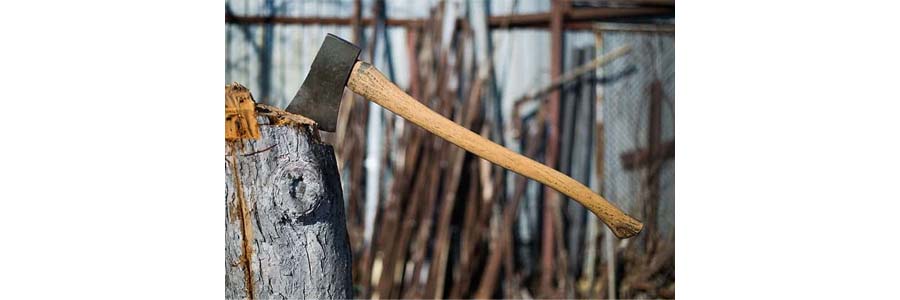
Weight and Balance
When choosing the right tool for your needs, it’s important to consider the weight and balance of an axe. The weight of an axe can significantly impact its performance. Heavier axes provide more power and force, making them suitable for chopping larger logs or splitting wood. However, they can also be more tiring to use over long periods of time. Finding a balance that feels comfortable is crucial to effectively control the axe. Some axes offer adjustable weights or handle lengths, allowing you to customize the tool to your preferences. By considering the weight and balance, you can choose an axe that meets your requirements without compromising on comfort and control.
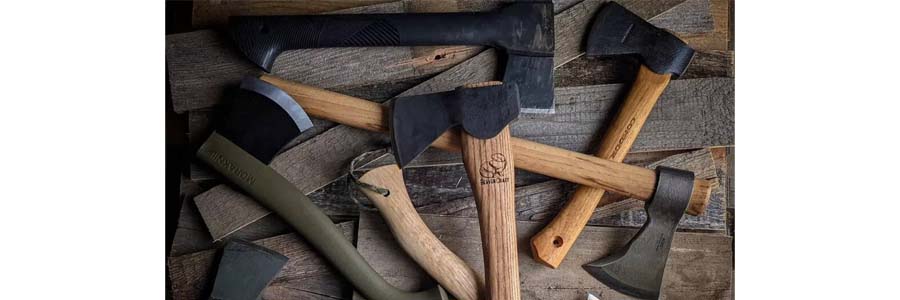
Handle Material and Design
When it comes to the durability and performance of an axe, the material and design of the handle play a significant role. There are different types of axe handles available, including wood, fiberglass, and synthetic materials such as carbon fiber or composite. Wood handles offer a traditional look and feel but may require more maintenance to prevent splintering or cracking. Fiberglass handles, on the other hand, are lightweight and durable, making them a popular choice for heavy-duty use. Synthetic materials provide both durability and a lightweight design, often with additional features like shock absorption or non-slip grips. It’s essential to consider your intended use when selecting the handle material and design, as different materials may be better suited to specific tasks or environments.
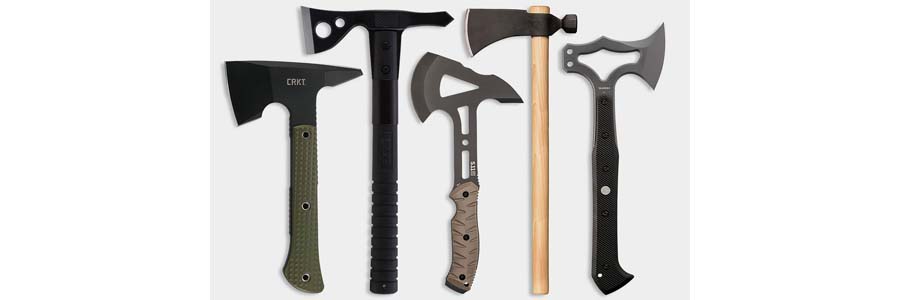
Exploring Various Types of Axes
When it comes to the different types of axes, there is a wide variety to choose from based on specific tasks and needs. One such type is the hatchet, which is a small and versatile axe commonly used for splitting wood and camping. Another type is the splitting maul, specifically designed for splitting logs with its heavy head and long handle. For felling trees, the felling axe is ideal, featuring a thin and sharp blade along with a longer handle for leverage. Carpenter’s axes are lightweight and compact, perfect for shaping wood and fine woodworking tasks. The double bit axe stands out with its two blades on opposite sides of the head, providing different cutting angles and versatility. Finally, the broad axe, often used in timber framing and log building, has a wide blade beveled on one side.
Tactical Axe
A tactical axe is a versatile tool that combines the functions of an axe, hammer, and pry bar. It is designed for survival situations and can be used for chopping wood, breaking through doors or windows, and self-defense. These axes typically have a compact size and lightweight design, making them easy to carry and maneuver. They often feature durable construction with a sharp blade made from high-quality steel. In addition, tactical axes may include additional features such as a built-in compass, firestarter, or paracord handle for added functionality in emergency situations. With their multifunctionality and practical design, tactical axes are essential tools for adventurers, outdoor enthusiasts, and survivalists.

Grub Axe
A grub axe, also known as a mattock or adze, is a specialized type of axe that serves a unique purpose in gardening, landscaping, and forestry work. Specifically designed for digging and cutting through roots and hard soil, the grub axe features a shorter handle and a heavier head compared to other types of axes. The blade of a grub axe is wider and flatter, providing better leverage when digging or chopping. This tool is commonly used to remove tree stumps and clear out root systems. To ensure safety while using a grub axe, it’s important to wear protective gear such as gloves and safety glasses.

Felling Axe
A felling axe, also known as a tree-felling axe, is a specialized tool designed specifically for chopping down trees. It features a long handle and a sharp, narrow blade that allows for precise and efficient cutting. Felling axes are typically heavier than other types of axes, providing extra power when swinging and making them ideal for this demanding task. The slightly curved handle of a felling axe offers better leverage and control, enabling loggers and forestry professionals to effectively tackle tree removal. In addition to its primary function, a felling axe can also be used for tasks such as splitting firewood.
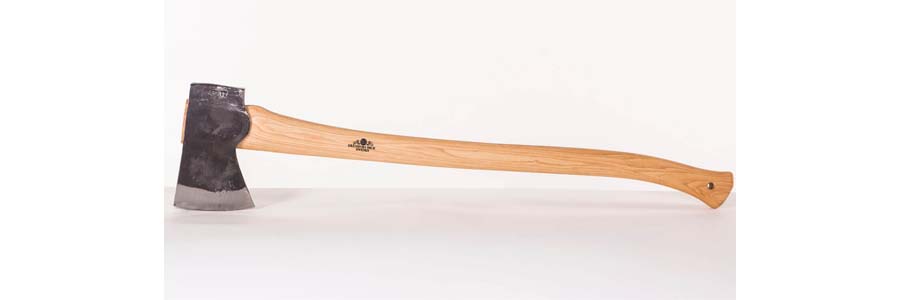
Forest Axe
The forest axe, also known as a felling axe or chopping axe, is designed specifically for cutting down trees and splitting wood. It is distinguishable by its longer handle and heavier head compared to other types of axes. The longer handle provides leverage for powerful swings, while the heavier head allows for more forceful chopping. Forest axes often have a curved bit, which helps to prevent the axe from getting stuck in the wood. These axes are commonly used by forestry workers, loggers, and outdoor enthusiasts for various tasks such as clearing trails and building shelters.

Hatchet
A hatchet, also known as a small, single-handed axe, is a versatile tool with a short handle measuring around 10-14 inches in length. It is commonly used for tasks like splitting kindling, chopping small branches, or clearing brush. Ideal for camping and other outdoor activities, hatchets are lightweight and portable. They typically feature a narrow blade with a sharp cutting edge on one side and a blunt hammer-like surface on the other. The compact size of hatchets allows for greater control and precision when performing tasks that require finesse.

Splitting Maul
A splitting maul, a powerful and heavy axe designed specifically for splitting wood, is an essential tool for homeowners, firewood enthusiasts, and professional loggers. With its thick, wedge-shaped head, it can easily split logs along the grain, making it highly efficient for tasks such as chopping firewood or preparing logs for woodworking projects. Weighing between 6 and 8 pounds, the splitting maul provides maximum force when swung. Its longer handle offers leverage and allows for a two-handed grip, enabling better control and generating more power during use. The splitting maul’s versatility and effectiveness make it an indispensable tool for anyone involved in wood-related tasks.

Broad Axe
The broad axe is a large, heavy axe with a wide blade. It is commonly used in woodworking for shaping and hewing logs. This type of axe features a single beveled blade that is flat on one side and curved on the other. It can be utilized for both roughing out and finishing work, requiring skill and technique to wield effectively. When used correctly, the broad axe can produce smooth and precise cuts. With its unique design and functionality, it serves as a valuable tool for carpenters and woodworkers in creating intricate and detailed wooden pieces.
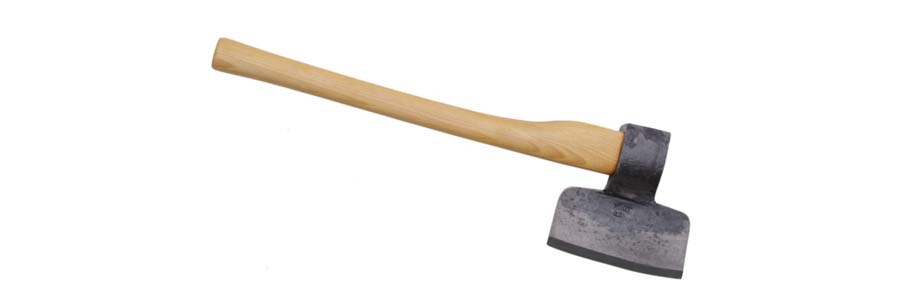
Carpenter’s Axe
Carpenter’s axes are specifically designed for woodworking tasks. With a shorter handle and a narrow, curved blade, they are ideal for shaping and smoothing wood. The blade of a carpenter’s axe may be single-beveled or double-beveled, depending on the intended use. These axes are commonly used by carpenters, furniture makers, and woodworkers for tasks such as hewing, carving, and shaping timber. In addition to woodworking, carpenter’s axes can also be used for general chopping and splitting tasks, making them versatile tools for woodworkers. Carpenters often rely on the precision and control provided by a carpenter’s axe to achieve fine details in their craft.
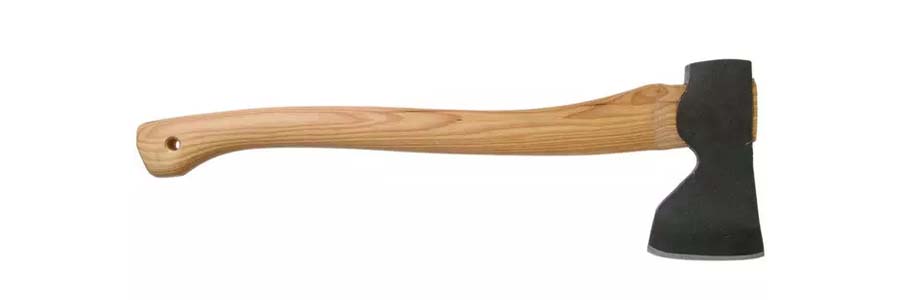
Miner’s Axe
The miner’s axe, also known as a pickaxe or mattock, is a heavy-duty tool designed for demanding chopping and digging tasks. Its dual-purpose head features a cutting edge on one side and a pointed tip on the other. The cutting edge is perfect for chopping and splitting wood, while the pointed tip is ideal for breaking up soil or rocks. To provide leverage for powerful swings, miner’s axes often have a longer handle than other types of axes. As a result, they are widely utilized in the mining, construction, and landscaping industries.

Double Bit Axe
The double bit axe, a versatile type of axe, features two cutting edges on opposite sides of the axe head. Traditionally used for felling trees and splitting wood, it offers enhanced functionality in chopping and shaping wood due to the dual cutting edges. It’s crucial to consider the weight and balance of the double bit axe, as it can vary depending on your specific needs and preferences. Some double bit axes have one sharp edge and one blunt edge, while others boast two sharp edges. With its unique design, the double bit axe offers woodworkers and outdoor enthusiasts increased versatility in their woodworking and outdoor tasks.

Viking Axe
The Viking axe, a historical axe design wielded by the Vikings in the medieval era, is a remarkable tool. It boasts a long handle and a wide, curved blade with a sharp edge. Versatility is a standout feature of the Viking axe, as it can be used for chopping wood and engaging in combat. The distinctive shape of the blade allows for cutting and hooking actions, making it highly effective in close-quarters battles. Nowadays, Viking axes find their place in historical reenactments and serve as charming decorative pieces. The legacy of the Viking axe lives on, showcasing its enduring impact on history and culture.

Tomahawk
The tomahawk is a versatile and lightweight axe, originally used by Native Americans as a tool and weapon. It features a narrow, straight blade with a sharp cutting edge on one side and a pick or hammerhead on the other. Tomahawks are often used for camping, hiking, and survival purposes due to their compact size and multi-functionality. They can be used for chopping, splitting, hammering, and even throwing in some cases. Modern tomahawks come in various styles and designs, including tactical versions for military and law enforcement use.

Pick Axe
A pick axe is a versatile tool commonly used for digging, breaking up hard soil, and removing rocks or roots. It consists of a long handle with a pointed pick on one end and a flat blade on the other. The pick end is designed for breaking up hard surfaces, while the blade end can be used for chopping or splitting wood. Pick axes are commonly used in construction, landscaping, and mining industries. When using a pick axe, it’s important to wear protective gear such as gloves and safety glasses to prevent injuries.

Roofing Axe
A roofing axe is a specialized type of axe used for cutting and shaping roofing materials like asphalt shingles. It is designed with a shorter handle, making it easier to maneuver in tight spaces. The blade of a roofing axe is typically curved and sharpened on one side, allowing for precise cuts. Some roofing axes also feature a hammerhead on the opposite side, which can be used for driving nails or removing old roofing materials. Professional roofers and DIY enthusiasts often use roofing axes for tasks such as cutting shingles, trimming flashing, and removing old roofing materials.

Hunter’s Axe
The hunter’s axe is a versatile tool commonly used for chopping wood and clearing brush. With its longer handle and narrower blade, it allows for more precise cuts compared to other types of axes. Designed for outdoor activities such as camping, hunting, and survival situations, the hunter’s axe is a compact and easily maneuverable tool. It can also be used for splitting small logs and kindling, making it an essential tool for outdoor enthusiasts. Whether you’re camping in the wilderness or preparing firewood for your backyard, the hunter’s axe is a reliable companion that combines functionality and portability.
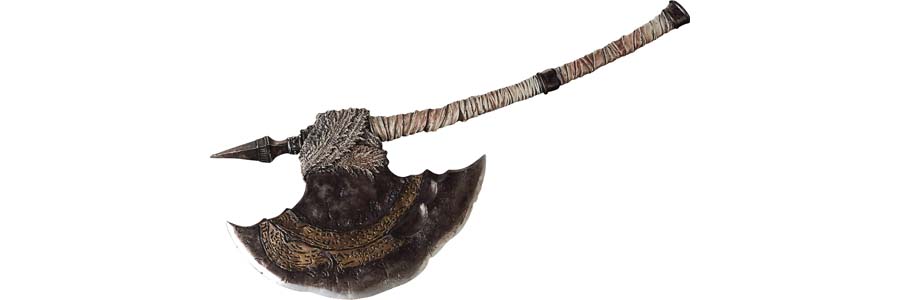
Throwing Axe
Throwing axes are specifically designed for the sport of axe throwing. They typically have a shorter handle and a heavier head, which improves accuracy and balance during throws. These axes often feature a double-edged blade, allowing for various throwing styles. Throwing axes are commonly used in competitions and recreational activities, providing hours of fun for enthusiasts. However, it’s crucial to practice proper technique and follow safety precautions to ensure a successful throw. With their unique characteristics and purpose-built design, throwing axes are the perfect choice for those looking to engage in this exciting and challenging sport.

Crash Axe
A crash axe, commonly used in aviation emergencies, is a specialized type of axe. It is designed to be smaller and lighter than traditional axes, with a curved or hooked blade. The main purpose of a crash axe is to efficiently cut through aircraft materials during emergency evacuations. These axes are easily accessible and often include additional features like a pry bar, oxygen tank wrench, or seatbelt cutter. While primarily used in aviation, crash axes can also be valuable in other emergency situations that require quick and precise cutting.

Adze
The adze, a type of axe, features a curved blade that is perpendicular to the handle. It is commonly utilized in woodworking and timber framing for shaping wood, such as carving or hollowing out logs. Additionally, the adze can be employed to smooth surfaces or remove bark from trees. Whether handheld or attached to a long handle, it offers versatility and enhanced leverage. The adze finds its roots in traditional woodworking practices and continues to be a valuable tool in various industries. With its unique design and functionality, the adze remains a reliable choice for craftsmen seeking precision and efficiency in their projects.
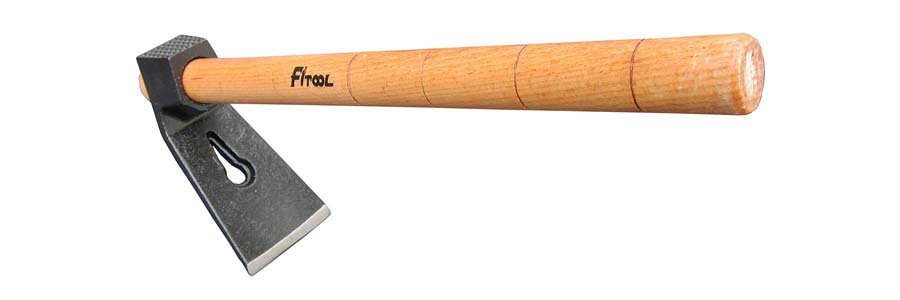
Battle axes
Battle axes were commonly used as weapons in warfare throughout history. These powerful tools featured a long handle and a large, heavy blade, making them ideal for chopping, slashing, and piercing. Knights and warriors in medieval times relied on battle axes for their versatility and effectiveness in combat. Today, battle axes are primarily used for historical reenactments and as decorative pieces, showcasing their rich historical significance. With their distinct design and historical importance, battle axes continue to captivate the imagination of people interested in the Middle Ages and the art of warfare.

Ice axe
Ice axes are specialized axes that cater to the needs of climbers and mountaineers in icy or snowy conditions. They typically feature a long shaft with a pick at one end and an adze or hammer at the other. The pick is essential for self-arresting during falls on steep slopes, while the adze or hammer can be used to chop steps in the ice or clear away loose snow. Ice axes are often constructed with lightweight yet durable materials like aluminum or carbon fiber to reduce weight during climbing. They may also have a curved shaft for enhanced grip and ergonomics, along with a leash to prevent accidental drops.

How to choose the right axe for your needs?
Consider your intended use when choosing an axe. Whether you’re chopping wood, felling trees, or going camping, it’s important to select the right tool for the job. Pay attention to the weight and length of the axe, as this will greatly impact comfort and usability. Additionally, consider the type of head that is best suited for your needs, such as a splitting maul for splitting logs or a felling axe for cutting down trees. To make an informed decision, seek advice from experts in the field and read reviews from other users who have experience with different axes. By taking these factors into consideration, you can ensure that you choose an axe that is not only effective but also tailored to your specific needs and preferences.
Conclusion
In conclusion, choosing the right axe involves considering various factors such as the intended function and use, weight and balance, and handle material and design. Understanding the history and evolution of axes can also provide valuable insights. Whether you need a tactical axe, felling axe, or throwing axe, it’s important to select one that suits your specific needs and preferences. To learn more about the different types of axes and make an informed decision, check out our comprehensive guide. Find the perfect axe for your needs today!
